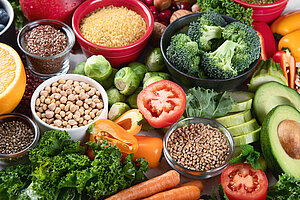While the year is still young, 2023 food trends are already starting to show up in how people cook and eat. These trends have been observed in data pulled from various sources. These sources include interviews with leading food journalists and input from chefs, pastry chefs, and mixologists. In addition, insights come from a commissioned food service survey with Technomic and secondary research sources. These food trend predictions are often continuations of trends and themes that we saw develop last year.
Themes
One of the megatrends from 2022 was the reduction in the prevalence of sugary and sweet flavor profiles in favor of more bitter ones. This shift has continued to grow in 2023 towards even more savory, vegetal, herbaceous, and umami tastes. Consumers have continued to reduce the amount of alcohol they consume. Low and even no alcohol consumer patterns have entered the mainstream. Beverage design has followed suit with flavors that taste better with little to no ABV. Global food trends have seen veganism become more mainstream and expand into new cuisines. So far, this year, food designed to be vegan foregoes the inclusion of meat alternatives without compromising taste. Last year, we saw smoky flavor profiles finding their way into unexpected places in beverages. This trend continues to evolve through multi-layered flavor profiles that include umami tastes.
In 2022, cuisines from different cultures bled into one another and this has further developed in the new year. For 2023 trends, the focus has become more personal by focusing on chefs' heritage and telling the stories of American immigrant experiences through diaspora cuisine. There was often a fusion of American comfort food with previously recognized multicultural flavors. Now that awareness of these flavors has grown, the formats of traditional comfort food have become the bases chefs are using to showcase new and regional global flavors. The playful riffs on American childhood nostalgia we saw in 2022 have served as a jumping-off point for reimagined and playful experimentations on gourmet junk food that utilizes childhood flavors from around the globe. As awareness of specific regional cuisines grew last year, it entered the mainstream. The focus has historically been on Chinese and Japanese cuisine, yet the focus now extends beyond Southeast Asian food cultures.
Find more trends in our weekly newsletter HERE
 Healthy Foods
Healthy Foods
Overall, there has continued to be a greater focus on a healthy lifestyle for both the consumer and the environment. Health trends have put vegetables at the forefront with a focus on locality and minimizing food waste. This is to reduce the carbon footprint created when shipping ingredients. It has also become common knowledge that locally grown foods are often more flavorful. While there has been a decrease in hedonistic luxuries in favor of healthy living, comfort food has served as a point of reference people are seeking out.
Climate concerns and supply chain issues are driving the push toward sourcing ingredients locally. Chefs and producers have adjusted to these demands from consumers. Dishes are being designed to showcase their unique tastes and ethical sourcing. An emphasis on the seasonality of produce drives consumption from a flavor perspective which also supports local economies. "Plant-forward" has become a buzzword that includes vegan food, vegetarian food, and other cooking styles.
Simultaneously, the desire to source more locally has been a growing demand for indigenous grains. The most sought-after ingredients so far this year are oysters, uni, river fish, and ancient grains like corn or farro. There is also a growing interest in more obscure cuts of beef like gracilis and coulotte due to an increased desire for ethical foods.
Fermentation has been a popular way to reduce waste so far this year. Pickled vegetables are being used to preserve in-season produce and minimize the waste from each harvest season. Interestingly enough, these pickled flavors have started to shine through in the dessert section of restaurant menus. Some of the most popular ingredients in desserts include peaches, tomatoes, buttermilk, and kombucha.
Related: New and exciting beverage trends
Ingredients
The shift to plant-forward cuisine has seen some ingredients move ahead in food and beverage trends. When looking at flavors used in beverages or sweets, pink pineapple, citrus lace, longan fruit, and cara cara have been some of the most popular ingredients requested. Beverage and dessert recipes have been including both pickled and brined ingredients. The most popular ingredients used solely in desserts include ancient grains, lavender lemon, pear elderflower, and strawberry rose. The theme of pickles and brine continues when looking at the most requested ingredients alongside seafood such as oysters and uni.
The ingredient choices are reflective of the overarching trends discussed earlier. Overall, an emphasis on decolonization has led to the widespread adoption of specific Southeast Asian ingredients. There is also an increased interest in pre-colonial cooking techniques and ancient grains. The use of preserved foods as showcase ingredients and flavors, as opposed to garnish, takes inspiration from Korean, Japanese, and Royal Thai cuisines. Additionally, these fermented ingredients are being used to add new complexity and color to desserts.
There continues to be a growing interest in organic and biodynamic wines. This interest has led to higher expectations from people in terms of transparency and sustainability. This interest might cause a greater focus on ethical or native spirits in the coming year.
In addition to local food sourcing, chefs and restaurants reduce waste by growing ingredients in-house and making more efficient use of waste. It is becoming more common for restaurants to have on-site gardens for growing herbs to be used in their recipes. These gardens are also spaces to compost leftovers and food scraps from production and service. Restaurants are also increasingly opting to make ingredients such as salad dressing in-house. They are also more likely to incorporate "ugly" fruits and vegetables that might not otherwise see purchase on the market. When unable to buy locally grown ingredients directly, suppliers who buy from local farmers are becoming more favored.
The roots and depths of many of these trends are deeper and more nuanced than a discussion of the overall trends of this year so far allows. In order to give these topics the focus they deserve, we'll be releasing additional articles in the future that will go further into the details of these topics.
Want to learn more about about our latest trends? Contact us here today!





